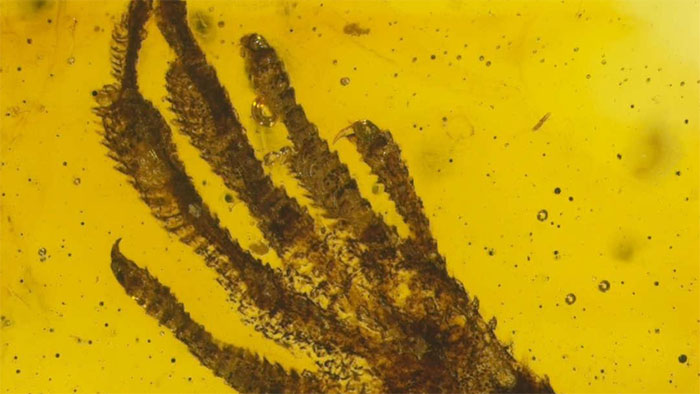Found tiny lizard legs in amber 20 million years old
For millions of years, the tiny left foot of an ancient lizard has been preserved in extremely rare amber until recently discovered.
At just 2cm cubic, the tiny foot belongs to a reptile belonging to the genus Anolis, the ancestor of the modern anole lizard .
A team of collaborating researchers is analyzing amber containing tiny lizard feet in the Dominican Republic as a basis to understand what happens to an organism during fossilization.
Although the feet seem to be in good condition, scientists say pale appearance can be deceived. Its physical structure is largely the same as it was 15 to 20 million years ago, but most of the bone has decomposed and its chemical properties have been altered.

Ancient lizard legs trapped in amber were discovered.
Researchers say this is an excellent component of amber. Amber acts as a barrier between organisms trapped within it and the external environment, often preserving a plant or animal in a three-dimensional posture.
Most organisms found in amber are insects that may have died when the sap gradually rolled over them, hardened and preserved them forever.
In order for an organism to be fossilized, it must first be quickly dipped into plastic, which prevents other animals from eating it or the microorganisms decomposing it. Over time, the original components of the organism were gradually replaced by minerals.
The preservation of organisms or their parts during long geological periods requires special conditions before and after the death of the organism. In addition, the natural chemical processes that occur in amber will sometimes weaken the organic soft tissue of preserved organisms.
Geologists from the University of Bonn in collaboration with the German Research Foundation and the Stuttgart State Museum of Natural History examined small lizard feet by preparing thin sections of fossils for microscopic analysis. by computerized tomography.
The claws and toes on the foot were so clear that the researchers could identify that the left foot was broken in two places. One of the broken bone locations is surrounded by a slight swelling, a sign that the animal may have been injured by a predator before it died. Another crack occurred after fossils were embedded in the sap of the same tree where a small crack in amber occurred.
Very little remains of the original tissue and bone elasticity have degenerated. In fact, bone tissue has been converted from hydroxyapatite, a mineral found in tooth enamel and bones, to a common phosphate mineral called fluorapatite .
Jonas Barthel, a PhD student at the University of Bonn's Institute of Geosciences, said this was surprising because the surrounding amber largely protects fossils from environmental impacts. The mechanisms behind the fossil process are currently of particular interest.
- Ancient lice trapped in amber 100 million years
- Found amber fur dinosaur, ancient lice 99 million years old
- Discovered the dead body stuck in amber 99 million years
- Mexico: Lizard discovered 23 million years old
- The flower is 100 million years old as freshly picked in amber
- Detecting fossil fossils strange 99 million years in amber
- Amazingly discovered about the 100 million-year-old bird in amber
- Found samples of amber weighing more than 2kg in Kaliningrad
- Detecting sea lizard fossils 75 million years
- Found amber fur dinosaur, ancient lice 99 million years old
- India discovered amber plates dating back 50 million years
- Finding frogs trapped in amber 99 million years
- The dragonfly trapped 100 million years in amber
- Fossil dragonflies lose their head 100 million years
 Discovered an ancient centipede fossil 99 million years old
Discovered an ancient centipede fossil 99 million years old Discovered bat-like dinosaurs in China
Discovered bat-like dinosaurs in China Discovered a 200-year-old bronze cannon of the coast
Discovered a 200-year-old bronze cannon of the coast Discover 305 million-year-old spider fossils
Discover 305 million-year-old spider fossils